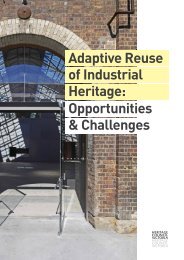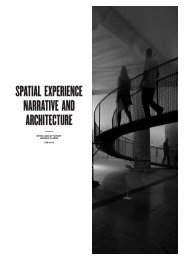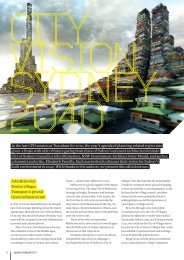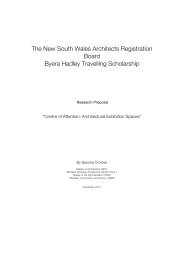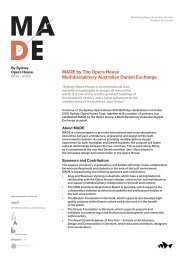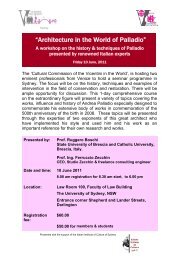4 unités LC - Architecture Insights
4 unités LC - Architecture Insights
4 unités LC - Architecture Insights
You also want an ePaper? Increase the reach of your titles
YUMPU automatically turns print PDFs into web optimized ePapers that Google loves.
But the ‘Unité’ of Firminy-Vert is still struggling, and perhaps this<br />
has something to do with the fact that it is the youngest. It will be<br />
interesting to see, in a few years time, how the state of this ‘Unité’<br />
has changed, if at all. And to see whether the progression of time<br />
will improve its state, as with its counterparts of Marseille and<br />
Briey, or whether it will simply deteriorate it.<br />
Fashion / Ideology<br />
As the ‘Unité d’habitation’ brought together so many of the ideas<br />
that established Le Corbusier’s reputation, they have become some<br />
of the works that most exemplify him as an architect and artist. But<br />
it is not only the physical elements of the design that have<br />
established their fame, it is equally the fact that they represent the<br />
most recognisable fragments of his most famous vision: La Ville<br />
Radieuse.<br />
This fame may in some cases been seen as having certain negative<br />
effects, such as the preserved impractical functioning of the roof<br />
terraces in Marseille and Rezé, and the social difficulties of mixing<br />
tourists and residents (also in Marseille). But the fame has equally<br />
aided, particularly in the cases of the three less renowned ‘Unités’,<br />
resulting in a greater level of general maintenance, with thanks<br />
mainly to architectural, artistic and historical associations that have<br />
subsequently taken interest in their causes.<br />
But it is not simply a matter of aesthetics that is considered in this<br />
physical preservation. Since those that truly make the buildings<br />
continue to live, are the inhabitants that carry out their lives with in<br />
them. And not all of these people are simply interested in history<br />
and styles. For although the majority of the population in the<br />
‘Unité’ of Marseille is of a professional middle-class standing and<br />
see the building as a fashionable place to live, the demographics of<br />
the three other ‘Unités’ is quite different.<br />
215 216<br />
The ‘Unités’ of Rezé-les-Nantes, and Firminy-Vert are both<br />
inhabited by a general working-class population. And the ‘Unité’<br />
of Briey-en-Forêt, although privately owned, has a true mix, not<br />
only of working and middle-class people, but equally of<br />
nationalities and backgrounds. So what is it about the ‘Unités’ that<br />
makes them so attractive to such a broad range of people? And<br />
why is it that they continue to hold such a passionate and<br />
supportive group of residents despite their varied histories,<br />
contexts and conditions?<br />
The answer to such questions is perhaps most eloquently put by<br />
Alan Colquhoun in his essay entitled The Significance of Le<br />
Corbusier –<br />
“On one hand, … his view of architecture as the means of moral<br />
and social regeneration seem seriously flawed. On the other, the<br />
plastic subtlety and metaphorical power of his buildings – their<br />
originality and certainty of touch – cannot be denied. And yet his<br />
indisputable greatness as an architect can hardly be dissociated<br />
from the grandeur of his vision and the ruthless single-mindedness<br />
with which he pursued it. If in so many ways, Le Corbusier was<br />
deluded, his delusion was that of the philosopher-architect for<br />
whom architecture, precisely because of the connection which it<br />
implies between the ideal and the real, was the expression of the<br />
profoundest truths. He occupies one of those rare moments in<br />
history when it seems that the vision of the artist and the man of<br />
passion converges with a collective myth.” 1<br />
For after visiting each of the four ‘Unités’ in France, talking to their<br />
inhabitants, and observing their functioning and existences, one<br />
thing arises above all else: that it is not simply a matter of ‘fashion’,<br />
but equally a matter of ideology. For tastes in fashion are not<br />
universal, and the appreciation of certain architectural styles is a<br />
purely subjective matter. So Le Corbusier may be criticised for his






